Changes in Plasma Concentration of Free Proteinogenic and Non-Proteinogenic Amino Acids in High-Performance Sprinters over a 6-Month Training Cycle
Abstract
1. Introduction
2. Materials and Methods
2.1. Participants
2.2. Study Design
2.3. Training Description
2.4. Dietary Macronutrients
2.5. Anthropometry and Body Composition
2.6. Exercise Test Protocol
2.7. Blood Drawing and Sampling
2.8. Determination of PFAA Concentration
2.9. Additional Blood Metabolites
2.10. Statistical Analysis
3. Results
3.1. Group Description
3.2. Proteinogenic PFAAs
3.3. Non-Proteinogenic PFAAs
3.4. Training Status Indicators
4. Discussion
4.1. Overtraining Context
4.2. Protein Balance
4.3. Toxic Ammonia Neutralization
4.4. Hydrogen Ion Buffering
4.5. Potential Practical Applications
4.6. Limitations and Strengths
5. Conclusions
Supplementary Materials
Author Contributions
Funding
Institutional Review Board Statement
Informed Consent Statement
Data Availability Statement
Acknowledgments
Conflicts of Interest
Appendix A
| No | Amino Acid | Abbrev. | MRM Transition (Q1 → Q3) | Collision Energy (eV) | Limit of Quantitation (μmol∙L−1) | |
|---|---|---|---|---|---|---|
| Analyte | Internal Std. | |||||
| 1 | 1-methylhistidine | 1MHis | 318.2 → 121.1 | 310.2 → 113.1 | 30 | 0.2 |
| 2 | 3-methylhistidine | 3MHis | 318.2 → 121.1 | 310.2 → 113.1 | 30 | 0.2 |
| 3 | alanine | Ala | 238.2 → 121.1 | 230.2 → 113.1 | 30 | 0.2 |
| 4 | anserine | Ans | 389.2 → 121.1 | 381.2 → 113.1 | 30 | 0.5 |
| 5 | arginine | Arg | 323.2 → 121.1 | 315.2 → 113.1 | 30 | 0.5 |
| 6 | argininosuccinic acid | Asa | 439.2 → 121.1 | 431.2 → 113.1 | 50 | 1.0 |
| 7 | asparagine | Asn | 281.2 → 121.1 | 273.2 → 113.1 | 30 | 0.5 |
| 8 | aspartic acid | Asp | 282.1 → 121.1 | 274.1 → 113.1 | 30 | 0.1 |
| 9 | carnosine | Car | 375.2 → 121.1 | 367.2 → 113.1 | 30 | 0.5 |
| 10 | citrulline | Cit | 324.2 → 121.1 | 316.2 → 113.1 | 30 | 0.5 |
| 11 | cystathionine | Cth | 519.3 → 121.1 | 503.3 → 113.1 | 50 | 0.5 |
| 12 | cystine | Cys | 537.2 → 121.1 | 521.2 → 113.1 | 50 | 1.0 |
| 13 | ethanolamine | EtN | 210.2 → 121.1 | 202.2 → 113.1 | 30 | 0.5 |
| 14 | glutamic acid | Glu | 296.2 → 121.1 | 288.2 → 113.1 | 30 | 0.5 |
| 15 | glutamine | Gln | 295.2 → 121.1 | 287.2 → 113.1 | 30 | 0.5 |
| 16 | glycine | Gly | 224.1 → 121.1 | 216.1 → 113.1 | 30 | 1.0 |
| 17 | histidine | His | 304.2 → 121.1 | 296.2 → 113.1 | 30 | 0.5 |
| 18 | homocitrulline | Hcit | 338.2 → 121.1 | 330.2 → 113.1 | 30 | 0.2 |
| 19 | homocystine | Hcy | 565.3 → 121.1 | 549.3 → 113.1 | 50 | 0.5 |
| 20 | hydroxyproline | Hyp | 280.1 → 121.1 | 272.1 → 113.1 | 30 | 0.2 |
| 21 | isoleucine | Ile | 280.2 → 121.1 | 272.2 → 113.1 | 30 | 0.5 |
| 22 | leucine | Leu | 280.2 → 121.1 | 272.2 → 113.1 | 30 | 0.5 |
| 23 | lysine | Lys | 443.3 → 121.1 | 427.3 → 113.1 | 50 | 0.5 |
| 24 | methionine | Met | 298.2 → 121.1 | 290.2 → 113.1 | 30 | 0.1 |
| 25 | ornithine | Orn | 429.3 → 121.1 | 413.3 → 113.1 | 50 | 0.5 |
| 26 | phenylalanine | Phe | 314.2 → 121.1 | 306.2 → 113.1 | 30 | 0.2 |
| 27 | phosphoethanolamine | PEtN | 290.1 → 121.1 | 282.1 → 113.1 | 30 | 0.5 |
| 28 | phosphoserine | PSer | 334.1 → 121.1 | 326.1 → 113.1 | 30 | 0.5 |
| 29 | proline | Pro | 264.2 → 121.1 | 256.2 → 113.1 | 30 | 0.1 |
| 30 | sarcosine | Sar | 238.2 → 121.1 | 230.2 → 113.1 | 30 | 0.2 |
| 31 | serine | Ser | 254.2 → 121.1 | 246.2 → 113.1 | 30 | 0.5 |
| 32 | taurine | Tau | 274.1 → 121.1 | 266.1 → 113.1 | 30 | 0.5 |
| 33 | threonine | Thr | 268.2 → 121.1 | 260.2 → 113.1 | 30 | 0.2 |
| 34 | tryptophan | Trp | 353.2 → 121.1 | 345.2 → 113.1 | 30 | 0.1 |
| 35 | tyrosine | Tyr | 330.2 → 121.1 | 322.2 → 113.1 | 30 | 0.5 |
| 36 | valine | Val | 266.2 → 121.1 | 258.2 → 113.1 | 30 | 0.2 |
| 37 | α-aminoadipic acid | Aad | 310.2 → 121.1 | 302.2 → 113.1 | 30 | 0.2 |
| 38 | α-amino-n-butyric acid | Abu | 252.2 → 121.1 | 244.2 → 113.1 | 30 | 0.2 |
| 39 | β-alanine | bAla | 238.2 → 121.1 | 230.2 → 113.1 | 30 | 0.5 |
| 40 | β-aminoisobutyric acid | bAib | 252.2 → 121.1 | 244.2 → 113.1 | 30 | 0.2 |
| 41 | γ-amino-n-butyric acid | GABA | 252.2 → 121.1 | 244.2 → 113.1 | 30 | 0.05 |
| 42 | δ-hydroxylysine | Hyl | 459.3 → 121.1 | 443.3 → 113.1 | 50 | 0.5 |
Appendix B

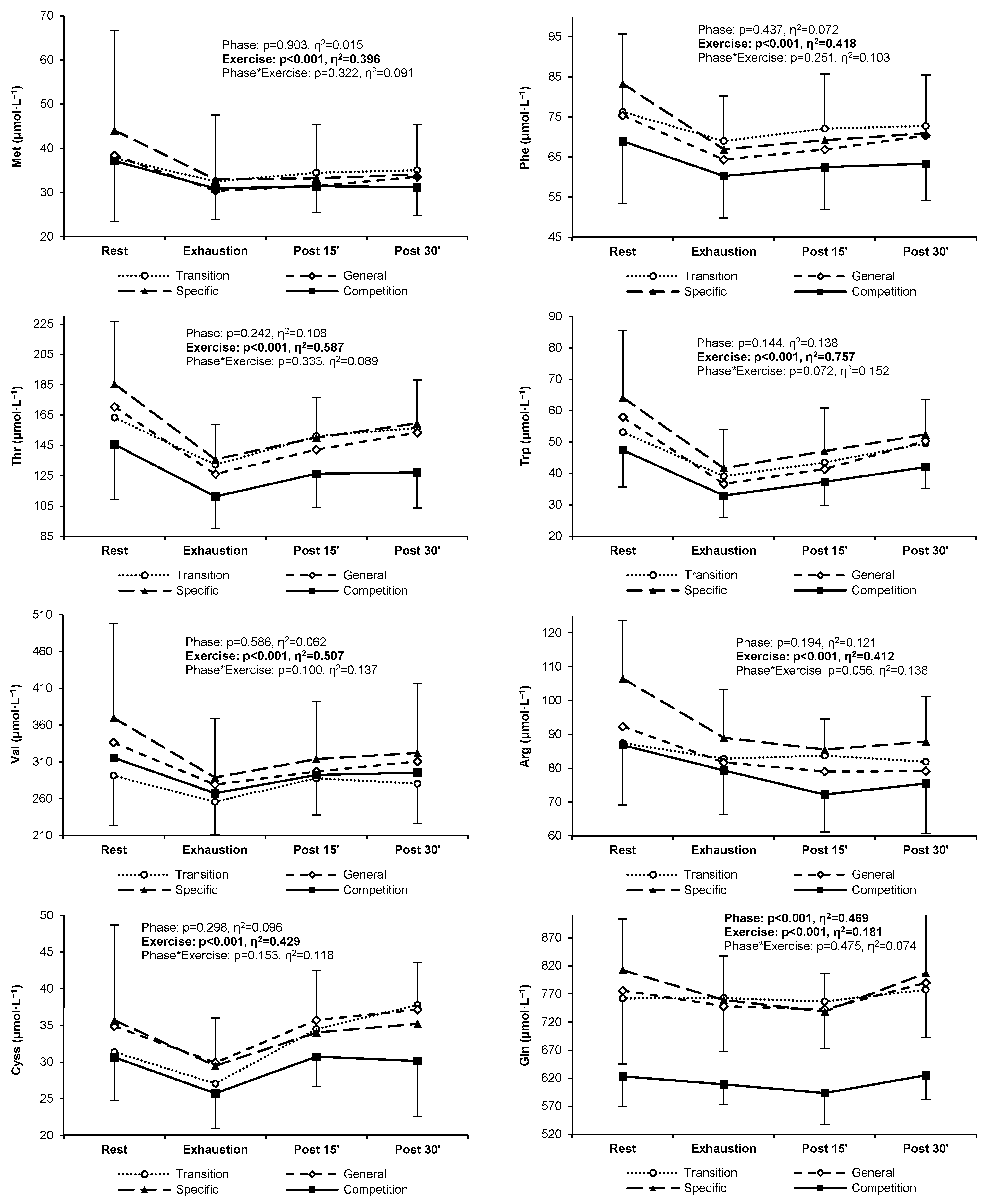
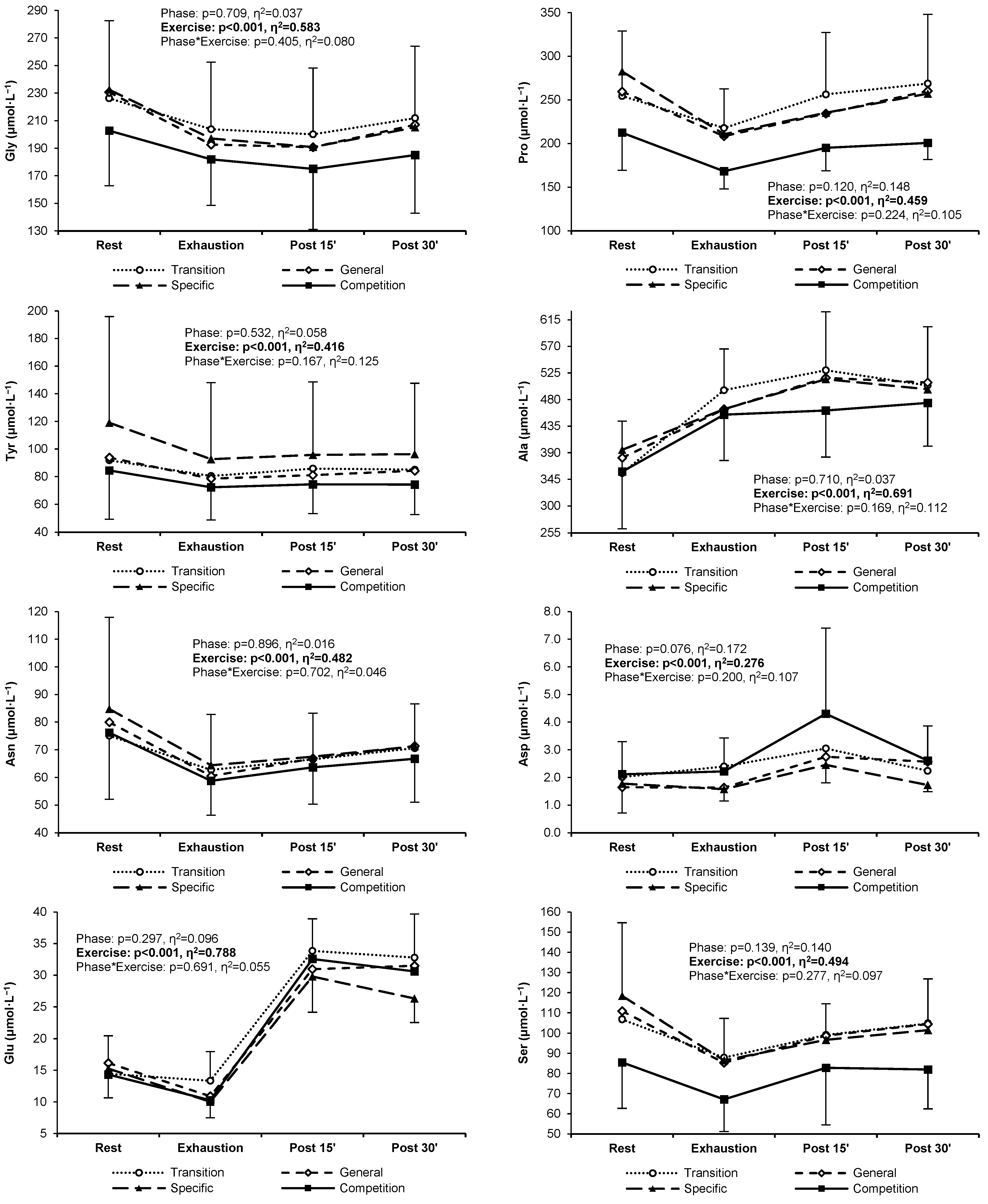
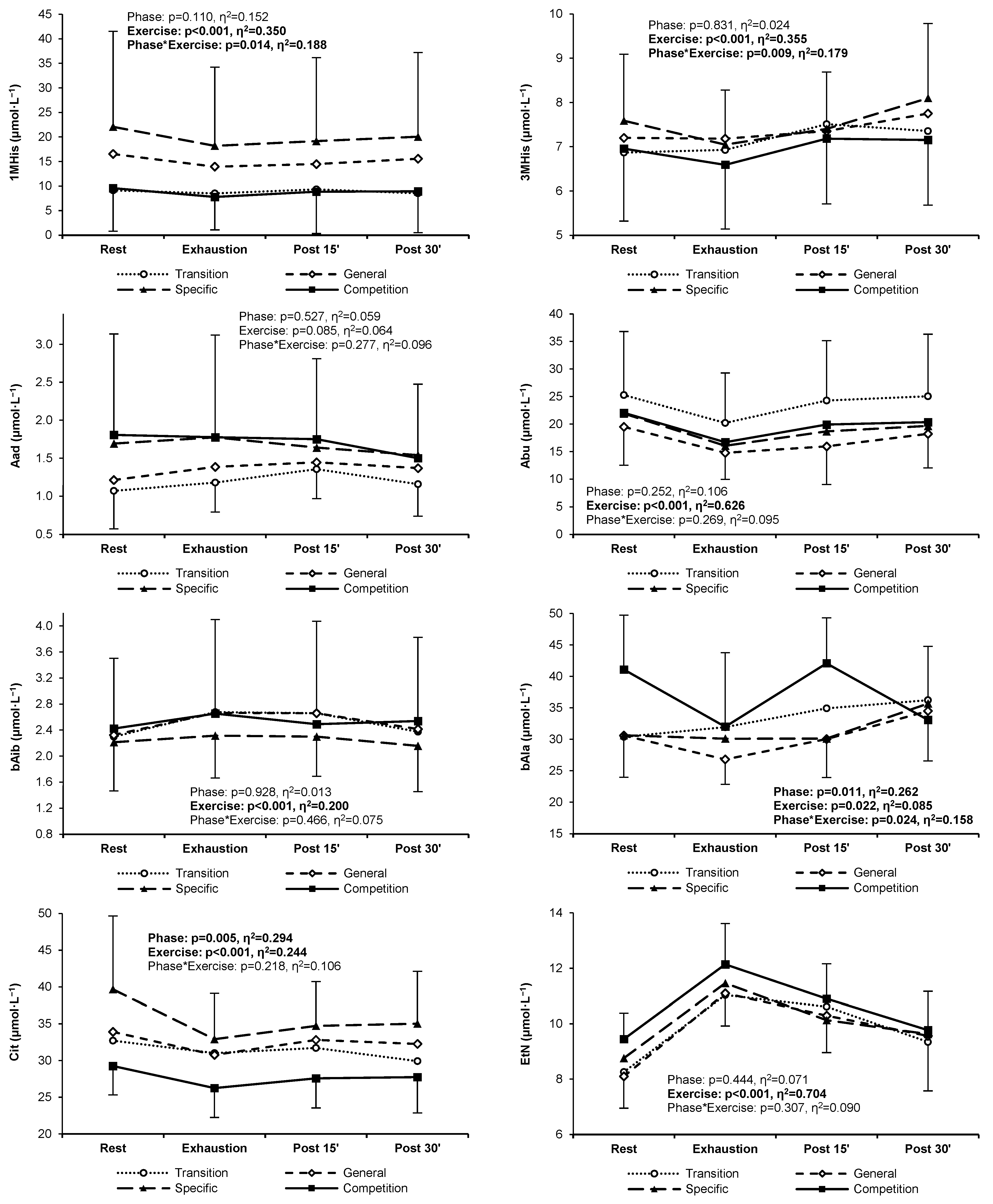
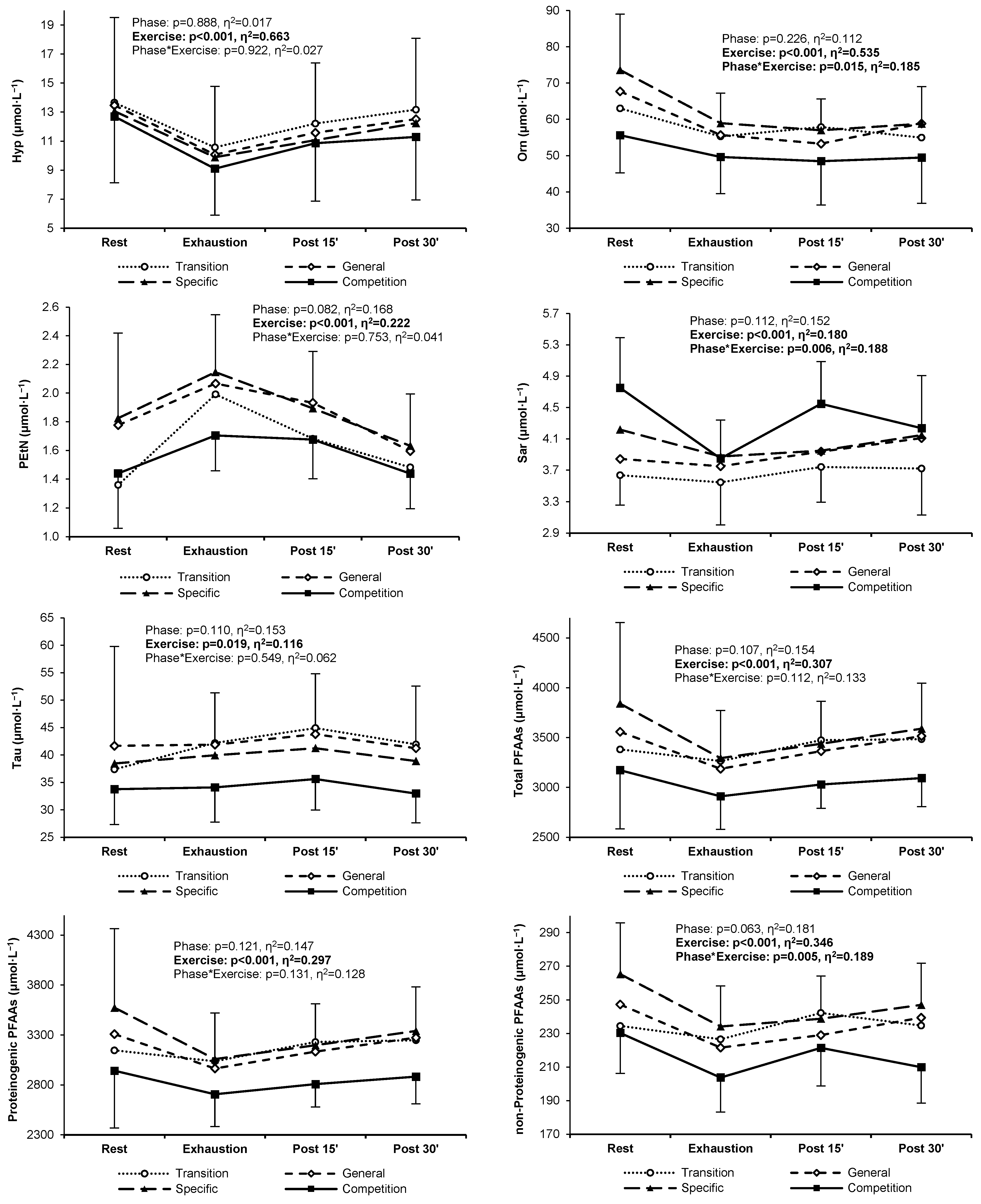

Appendix C
| Training Phase | Rest | Exhaustion | Recovery | ||||||
|---|---|---|---|---|---|---|---|---|---|
| 15 min | 30 min | ||||||||
| Mean | SD | Mean | SD | Mean | SD | Mean | SD | ||
| His | Transition | 89.0 | 14.8 | 83.8 | 9.8 | 95.0 | 14.5 | 92.6 | 16.8 |
| General | 87.7 | 11.5 | 80.5 | 10.7 | 89.2 | 10.9 | 90.1 | 15.0 | |
| Specific | 93.2 | 11.0 | 78.9 | 7.1 | 89.3 | 10.6 | 91.2 | 15.9 | |
| Competition | 75.1 | 9.6 | 69.9 | 6.2 | 77.6 | 8.4 | 75.9 | 7.3 | |
| Ile | Transition | 76.5 | 23.7 | 66.3 | 11.1 | 69.6 | 13.2 | 64.6 | 14.3 |
| General | 86.7 | 26.7 | 70.1 | 17.5 | 70.3 | 14.8 | 69.7 | 18.3 | |
| Specific | 98.9 | 46.2 | 70.8 | 24.2 | 71.0 | 16.3 | 75.2 | 32.1 | |
| Competition | 83.4 | 42.7 | 68.8 | 23.7 | 68.6 | 20.1 | 69.8 | 29.8 | |
| Leu | Transition | 143 | 39 | 126 | 15 | 133 | 19 | 126 | 21 |
| General | 155 | 41 | 126 | 25 | 130 | 25 | 131 | 30 | |
| Specific | 184 | 80 | 135 | 40 | 140 | 32 | 150 | 64 | |
| Competition | 148 | 68 | 123 | 40 | 128 | 36 | 129 | 52 | |
| Lys | Transition | 210 | 62 | 197 | 46 | 195 | 48 | 194 | 50 |
| General | 226 | 51 | 191 | 34 | 186 | 32 | 190 | 32 | |
| Specific | 249 | 73 | 205 | 43 | 194 | 41 | 199 | 42 | |
| Competition | 244 | 81 | 214 | 51 | 198 | 38 | 202 | 39 | |
| Met | Transition | 37.8 | 15.8 | 32.5 | 9.6 | 34.5 | 10.5 | 35.0 | 10.8 |
| General | 38.4 | 12.5 | 30.4 | 7.2 | 31.4 | 7.0 | 33.5 | 8.8 | |
| Specific | 44.0 | 22.7 | 33.0 | 14.5 | 33.2 | 12.2 | 34.1 | 11.3 | |
| Competition | 37.1 | 13.7 | 30.9 | 7.1 | 31.4 | 6.0 | 31.2 | 6.4 | |
| Phe | Transition | 76.2 | 19.5 | 69.0 | 11.2 | 72.1 | 13.6 | 72.7 | 12.7 |
| General | 75.4 | 14.6 | 64.4 | 7.9 | 66.9 | 8.5 | 70.4 | 11.6 | |
| Specific | 83.3 | 25.1 | 66.9 | 17.9 | 69.2 | 15.4 | 70.9 | 16.2 | |
| Competition | 68.9 | 15.6 | 60.3 | 10.4 | 62.5 | 10.5 | 63.3 | 9.1 | |
| Thr | Transition | 163 | 54 | 132 | 33 | 151 | 46 | 156 | 52 |
| General | 170 | 54 | 126 | 27 | 142 | 30 | 153 | 32 | |
| Specific | 185 | 41 | 136 | 23 | 150 | 26 | 159 | 29 | |
| Competition | 146 | 36 | 111 | 21 | 126 | 22 | 127 | 23 | |
| Trp | Transition | 53.1 | 17.4 | 39.1 | 9.2 | 43.4 | 10.6 | 49.6 | 11.6 |
| General | 57.9 | 10.9 | 36.6 | 6.1 | 41.3 | 6.5 | 50.3 | 6.2 | |
| Specific | 64.1 | 21.5 | 41.7 | 12.4 | 47.0 | 13.8 | 52.4 | 11.2 | |
| Competition | 47.4 | 11.7 | 32.9 | 6.8 | 37.3 | 7.4 | 42.0 | 6.7 | |
| Val | Transition | 291 | 68 | 256 | 44 | 288 | 68 | 280 | 54 |
| General | 336 | 89 | 279 | 62 | 297 | 89 | 311 | 72 | |
| Specific | 370 | 128 | 289 | 81 | 314 | 128 | 322 | 95 | |
| Competition | 316 | 101 | 267 | 68 | 292 | 101 | 295 | 75 | |
| Arg | Transition | 87.4 | 19.1 | 82.8 | 17.0 | 83.7 | 15.9 | 81.9 | 16.1 |
| General | 92.3 | 21.2 | 81.7 | 15.4 | 79.0 | 14.8 | 79.1 | 14.1 | |
| Specific | 106.5 | 17.1 | 89.0 | 14.3 | 85.5 | 9.1 | 87.8 | 13.3 | |
| Competition | 86.8 | 17.7 | 79.3 | 13.1 | 72.2 | 11.1 | 75.5 | 14.8 | |
| Cyss | Transition | 31.4 | 6.0 | 27.1 | 6.5 | 34.5 | 5.7 | 37.8 | 7.5 |
| General | 34.9 | 13.8 | 29.9 | 6.1 | 35.7 | 6.8 | 37.2 | 6.5 | |
| Specific | 35.7 | 7.1 | 29.5 | 6.3 | 34.0 | 7.2 | 35.2 | 6.2 | |
| Competition | 30.6 | 5.9 | 25.8 | 4.8 | 30.8 | 4.1 | 30.2 | 7.5 | |
| Gln | Transition | 762 | 117 | 763 | 95 | 756 | 83 | 778 | 85 |
| General | 776 | 104 | 748 | 89 | 743 | 109 | 790 | 99 | |
| Specific | 812 | 91 | 759 | 79 | 739 | 67 | 807 | 104 | |
| Competition | 623 | 53 | 609 | 36 | 594 | 57 | 625 | 43 | |
| Gly | Transition | 226 | 56 | 204 | 49 | 200 | 48 | 212 | 52 |
| General | 231 | 72 | 193 | 49 | 191 | 58 | 207 | 64 | |
| Specific | 233 | 53 | 197 | 44 | 191 | 45 | 205 | 58 | |
| Competition | 203 | 40 | 182 | 33 | 175 | 44 | 185 | 42 | |
| Pro | Transition | 254 | 75 | 218 | 45 | 256 | 71 | 269 | 79 |
| General | 259 | 83 | 208 | 53 | 234 | 53 | 260 | 64 | |
| Specific | 283 | 109 | 211 | 56 | 235 | 54 | 257 | 56 | |
| Competition | 212 | 43 | 168 | 20 | 195 | 26 | 201 | 19 | |
| Tyr | Transition | 91.9 | 40.5 | 80.5 | 26.0 | 85.8 | 31.5 | 85.1 | 29.3 |
| General | 93.8 | 29.6 | 78.6 | 20.5 | 81.1 | 19.1 | 84.3 | 20.5 | |
| Specific | 119.0 | 76.9 | 92.7 | 55.4 | 95.7 | 52.9 | 96.2 | 51.4 | |
| Competition | 84.5 | 35.1 | 72.3 | 23.4 | 74.4 | 20.9 | 74.2 | 21.4 | |
| Ala | Transition | 356 | 88 | 496 | 70 | 530 | 99 | 504 | 99 |
| General | 381 | 91 | 464 | 55 | 517 | 64 | 509 | 66 | |
| Specific | 395 | 95 | 464 | 67 | 514 | 90 | 497 | 95 | |
| Competition | 358 | 96 | 454 | 77 | 461 | 79 | 474 | 73 | |
| Asn | Transition | 75.1 | 21.6 | 62.7 | 13.3 | 66.5 | 12.7 | 70.6 | 17.0 |
| General | 80.0 | 19.8 | 60.5 | 10.0 | 66.9 | 10.6 | 71.3 | 16.1 | |
| Specific | 84.8 | 33.2 | 64.4 | 18.3 | 67.5 | 15.8 | 71.3 | 15.3 | |
| Competition | 76.2 | 24.1 | 58.8 | 12.5 | 63.7 | 13.3 | 66.7 | 15.7 | |
| Asp | Transition | 2.02 | 0.84 | 2.40 | 1.03 | 3.05 | 0.94 | 2.24 | 0.80 |
| General | 1.65 | 0.50 | 1.63 | 0.53 | 2.75 | 0.63 | 2.57 | 1.29 | |
| Specific | 1.77 | 1.06 | 1.58 | 0.42 | 2.46 | 0.65 | 1.73 | 0.24 | |
| Competition | 2.12 | 1.18 | 2.22 | 1.21 | 4.30 | 3.10 | 2.61 | 1.26 | |
| Glu | Transition | 14.5 | 6.0 | 13.3 | 4.6 | 33.9 | 5.1 | 32.8 | 6.9 |
| General | 16.1 | 6.0 | 10.9 | 4.1 | 31.0 | 7.5 | 31.5 | 10.2 | |
| Specific | 15.3 | 4.6 | 10.0 | 2.6 | 29.8 | 5.6 | 26.3 | 3.7 | |
| Competition | 14.3 | 5.8 | 10.3 | 3.3 | 32.6 | 7.5 | 30.6 | 10.3 | |
| Ser | Transition | 106.8 | 34.2 | 87.9 | 23.0 | 99.1 | 23.7 | 104.8 | 29.8 |
| General | 110.9 | 28.9 | 85.3 | 20.4 | 98.8 | 22.8 | 104.5 | 23.6 | |
| Specific | 118.4 | 36.3 | 86.5 | 20.7 | 96.7 | 17.9 | 101.5 | 25.4 | |
| Competition | 85.5 | 22.8 | 67.1 | 15.9 | 82.8 | 28.3 | 81.9 | 19.5 | |
| 1MHis | Transition | 9.1 | 8.6 | 8.5 | 8.7 | 9.3 | 8.5 | 8.5 | 8.7 |
| General | 16.5 | 10.5 | 13.9 | 9.1 | 14.5 | 9.2 | 15.6 | 9.9 | |
| Specific | 22.1 | 19.4 | 18.2 | 16.0 | 19.1 | 17.0 | 20.1 | 17.1 | |
| Competition | 9.6 | 8.8 | 7.8 | 6.7 | 8.8 | 8.5 | 8.9 | 8.4 | |
| 3MHis | Transition | 6.37 | 1.21 | 6.43 | 1.39 | 7.01 | 1.47 | 6.86 | 1.72 |
| General | 6.70 | 1.26 | 6.68 | 1.51 | 6.85 | 1.39 | 7.25 | 1.51 | |
| Specific | 7.09 | 1.50 | 6.55 | 1.23 | 6.90 | 1.29 | 7.60 | 1.69 | |
| Competition | 6.46 | 1.64 | 6.09 | 1.45 | 6.68 | 1.48 | 6.65 | 1.47 | |
| Aad | Transition | 1.07 | 0.50 | 1.18 | 0.39 | 1.36 | 0.39 | 1.16 | 0.42 |
| General | 1.21 | 0.56 | 1.39 | 0.66 | 1.45 | 0.62 | 1.37 | 0.56 | |
| Specific | 1.69 | 1.21 | 1.78 | 1.65 | 1.64 | 1.13 | 1.54 | 0.92 | |
| Competition | 1.81 | 1.33 | 1.78 | 1.35 | 1.75 | 1.06 | 1.50 | 0.97 | |
| Abu | Transition | 25.3 | 11.5 | 20.2 | 9.1 | 24.3 | 10.9 | 25.0 | 11.3 |
| General | 19.5 | 7.0 | 14.8 | 4.8 | 15.9 | 6.9 | 18.2 | 6.2 | |
| Specific | 21.9 | 7.5 | 16.1 | 5.1 | 18.7 | 6.0 | 19.7 | 5.2 | |
| Competition | 22.0 | 7.4 | 16.7 | 4.8 | 19.9 | 5.5 | 20.3 | 5.5 | |
| bAib | Transition | 2.30 | 1.28 | 2.68 | 1.48 | 2.66 | 1.45 | 2.37 | 1.28 |
| General | 2.33 | 1.18 | 2.67 | 1.43 | 2.66 | 1.42 | 2.42 | 1.18 | |
| Specific | 2.21 | 0.75 | 2.32 | 0.65 | 2.30 | 0.61 | 2.16 | 0.75 | |
| Competition | 2.42 | 0.78 | 2.65 | 0.94 | 2.49 | 0.97 | 2.54 | 0.78 | |
| bAla | Transition | 30.4 | 7.3 | 31.9 | 7.3 | 34.9 | 5.5 | 36.2 | 9.6 |
| General | 30.6 | 6.6 | 26.8 | 4.0 | 30.0 | 6.1 | 34.5 | 7.9 | |
| Specific | 30.6 | 6.4 | 30.1 | 6.7 | 30.1 | 5.3 | 35.7 | 4.8 | |
| Competition | 41.1 | 8.6 | 32.0 | 11.8 | 42.1 | 7.2 | 33.1 | 11.7 | |
| Cit | Transition | 32.7 | 3.3 | 31.0 | 3.3 | 31.7 | 4.1 | 29.9 | 4.1 |
| General | 33.9 | 4.9 | 30.8 | 4.4 | 32.8 | 4.8 | 32.3 | 3.7 | |
| Specific | 39.7 | 10.0 | 32.9 | 6.2 | 34.7 | 6.0 | 35.0 | 7.1 | |
| Competition | 29.2 | 3.9 | 26.2 | 4.0 | 27.6 | 4.0 | 27.7 | 4.9 | |
| EtN | Transition | 8.26 | 1.20 | 11.04 | 1.51 | 10.62 | 1.21 | 9.35 | 1.45 |
| General | 8.10 | 1.15 | 11.10 | 1.18 | 10.30 | 1.33 | 9.56 | 1.99 | |
| Specific | 8.76 | 1.44 | 11.46 | 1.95 | 10.13 | 1.44 | 9.63 | 1.43 | |
| Competition | 9.45 | 0.93 | 12.14 | 1.48 | 10.90 | 1.26 | 9.77 | 1.40 | |
| Hyp | Transition | 13.7 | 5.9 | 10.6 | 4.2 | 12.2 | 4.2 | 13.2 | 4.9 |
| General | 13.5 | 5.3 | 10.1 | 3.9 | 11.6 | 4.5 | 12.5 | 4.0 | |
| Specific | 13.1 | 3.3 | 9.9 | 2.8 | 11.1 | 3.0 | 12.2 | 3.6 | |
| Competition | 12.7 | 4.6 | 9.1 | 3.2 | 10.9 | 4.0 | 11.3 | 4.3 | |
| Orn | Transition | 63.0 | 18.7 | 55.3 | 13.9 | 57.9 | 14.8 | 55.0 | 15.6 |
| General | 67.7 | 15.5 | 55.7 | 11.8 | 53.3 | 9.6 | 58.9 | 14.1 | |
| Specific | 73.6 | 15.4 | 59.0 | 8.3 | 57.0 | 8.6 | 58.8 | 10.3 | |
| Competition | 55.6 | 10.3 | 49.6 | 10.1 | 48.5 | 12.1 | 49.4 | 12.6 | |
| PEtN | Transition | 1.36 | 0.39 | 1.99 | 0.47 | 1.68 | 0.35 | 1.48 | 0.34 |
| General | 1.78 | 1.11 | 2.07 | 0.41 | 1.93 | 0.36 | 1.59 | 0.35 | |
| Specific | 1.83 | 0.59 | 2.15 | 0.40 | 1.89 | 0.40 | 1.63 | 0.36 | |
| Competition | 1.44 | 0.38 | 1.70 | 0.25 | 1.68 | 0.27 | 1.44 | 0.24 | |
| Sar | Transition | 3.64 | 0.38 | 3.54 | 0.54 | 3.74 | 0.45 | 3.72 | 0.59 |
| General | 3.84 | 0.97 | 3.75 | 0.65 | 3.94 | 0.78 | 4.11 | 0.61 | |
| Specific | 4.22 | 1.20 | 3.88 | 0.77 | 3.95 | 0.63 | 4.15 | 0.69 | |
| Competition | 4.75 | 0.64 | 3.85 | 0.49 | 4.55 | 0.54 | 4.23 | 0.67 | |
| Tau | Transition | 37.4 | 5.8 | 42.2 | 6.5 | 44.9 | 5.4 | 41.9 | 7.1 |
| General | 41.7 | 18.1 | 41.9 | 9.4 | 43.8 | 11.0 | 41.2 | 11.3 | |
| Specific | 38.5 | 8.1 | 39.9 | 7.8 | 41.2 | 8.2 | 38.9 | 8.2 | |
| Competition | 33.8 | 6.5 | 34.1 | 6.3 | 35.6 | 5.7 | 33.0 | 5.4 | |
| Proteinogenic | Transition | 3147 | 655 | 3038 | 374 | 3231 | 471 | 3249 | 517 |
| General | 3311 | 573 | 2966 | 304 | 3134 | 337 | 3275 | 378 | |
| Specific | 3575 | 791 | 3060 | 462 | 3199 | 415 | 3341 | 441 | |
| Competition | 2943 | 574 | 2707 | 325 | 2808 | 229 | 2883 | 273 | |
| Essential | Transition | 1140 | 292 | 1002 | 157 | 1082 | 196 | 1072 | 202 |
| General | 1234 | 265 | 1004 | 146 | 1054 | 145 | 1098 | 175 | |
| Specific | 1371 | 421 | 1055 | 229 | 1107 | 202 | 1155 | 246 | |
| Competition | 1166 | 357 | 977 | 203 | 1022 | 165 | 1036 | 209 | |
| non-Essential | Transition | 2007 | 377 | 2037 | 235 | 2149 | 297 | 2177 | 328 |
| General | 2077 | 358 | 1962 | 197 | 2080 | 239 | 2177 | 247 | |
| Specific | 2204 | 382 | 2004 | 246 | 2091 | 230 | 2187 | 251 | |
| Competition | 1777 | 242 | 1730 | 131 | 1786 | 142 | 1847 | 111 | |
| BCAA | Transition | 511 | 128 | 448 | 68 | 491 | 80 | 471 | 85 |
| General | 578 | 153 | 475 | 101 | 498 | 102 | 511 | 117 | |
| Specific | 653 | 251 | 495 | 143 | 525 | 124 | 548 | 188 | |
| Competition | 547 | 210 | 459 | 129 | 489 | 112 | 494 | 151 | |
| non-Proteinogenic | Transition | 235 | 23 | 227 | 25 | 242 | 28 | 235 | 37 |
| General | 247 | 39 | 222 | 24 | 229 | 26 | 239 | 20 | |
| Specific | 265 | 31 | 234 | 24 | 239 | 25 | 247 | 25 | |
| Competition | 230 | 24 | 204 | 21 | 221 | 23 | 210 | 21 | |
| Total PFAAs | Transition | 3382 | 672 | 3265 | 389 | 3473 | 490 | 3484 | 543 |
| General | 3558 | 601 | 3187 | 323 | 3363 | 352 | 3514 | 393 | |
| Specific | 3841 | 813 | 3294 | 478 | 3437 | 427 | 3588 | 457 | |
| Competition | 3173 | 588 | 2911 | 332 | 3029 | 240 | 3093 | 285 | |
| Lactate | Transition | 1.34 | 0.50 | 11.07 | 1.21 | 7.12 | 1.93 | 4.50 | 1.55 |
| General | 1.34 | 0.57 | 10.42 | 1.67 | 6.32 | 1.69 | 3.66 | 1.51 | |
| Specific | 1.11 | 0.33 | 10.21 | 1.25 | 6.14 | 1.98 | 3.30 | 1.41 | |
| Competition | 0.94 | 0.19 | 9.75 | 1.30 | 5.22 | 1.30 | 2.67 | 0.92 | |
| Ammonia | Transition | 31.5 | 4.0 | 92.8 | 8.0 | 62.4 | 8.5 | 40.0 | 5.6 |
| General | 28.3 | 3.7 | 80.2 | 7.1 | 53.0 | 8.4 | 35.7 | 4.6 | |
| Specific | 25.9 | 2.3 | 70.6 | 7.0 | 45.5 | 5.1 | 32.2 | 4.9 | |
| Competition | 22.8 | 4.8 | 66.2 | 4.3 | 43.1 | 4.6 | 27.6 | 4.4 | |
| Phe:Tyr ratio | Transition | 0.90 | 0.18 | 0.91 | 0.19 | 0.90 | 0.19 | 0.91 | 0.19 |
| General | 0.84 | 0.15 | 0.85 | 0.17 | 0.85 | 0.17 | 0.86 | 0.17 | |
| Specific | 0.77 | 0.16 | 0.79 | 0.17 | 0.80 | 0.18 | 0.81 | 0.20 | |
| Competition | 0.86 | 0.15 | 0.87 | 0.16 | 0.87 | 0.16 | 0.89 | 0.16 | |
| Gln:Glu ratio | Transition | 59.1 | 22.3 | 63.6 | 24.5 | 22.8 | 4.0 | 24.5 | 5.4 |
| General | 54.3 | 23.9 | 79.1 | 34.0 | 25.9 | 9.9 | 27.6 | 9.8 | |
| Specific | 56.2 | 12.0 | 81.0 | 24.8 | 25.9 | 6.4 | 31.7 | 9.4 | |
| Competition | 48.6 | 15.9 | 63.9 | 16.7 | 19.2 | 5.0 | 22.5 | 7.3 | |
References
- Gibala, M.J. Regulation of skeletal muscle amino acid metabolism during exercise. Int. J. Sport Nutr. Exerc. Metab. 2001, 11, 87–108. [Google Scholar] [CrossRef] [PubMed]
- Felig, P.; Wahren, J. Amino acid metabolism in exercising man. J. Clin. Investig. 1971, 50, 2703–2714. [Google Scholar] [CrossRef] [PubMed]
- Henriksson, J. Effect of exercise on amino acid concentrations in skeletal muscle and plasma. J. Exp. Biol. 1991, 160, 149–165. [Google Scholar] [CrossRef] [PubMed]
- Ishikura, K.; Ra, S.-G.; Ohmori, H. Exercise-induced changes in amino acid levels in skeletal muscle and plasma. J. Phys. Fit. Sports Med. 2013, 2, 301–310. [Google Scholar] [CrossRef]
- Kamei, Y.; Hatazawa, Y.; Uchitomi, R.; Yoshimura, R.; Miura, S. Regulation of skeletal muscle function by amino acids. Nutrients 2020, 12, 261. [Google Scholar] [CrossRef]
- Rennie, M.J.; Tipton, K.D. Protein and amino acid metabolism during and after exercise and the effects of nutrition. Ann. Rev. Nutr. 2000, 20, 457–483. [Google Scholar] [CrossRef]
- Wagenmakers, A.J.M. Protein and Amino Acid Metabolism in Human Muscle. In Skeletal Muscle Metabolism in Exercise and Diabetes. Advances in Experimental Medicine and Biology, 1st ed.; Richter, E.A., Kiens, B., Galbo, H., Saltin, B., Eds.; Springer: Boston, MA, USA, 1998; Volume 441, pp. 287–314. [Google Scholar] [CrossRef]
- Abe, H. Role of histidine-related compounds as intracellular proton buffering constituents in vertebrate muscle. Biochemistry 2013, 65, 757–765. [Google Scholar]
- Wyss, M.; Kaddurah-Daouk, R. Creatine and creatinine metabolism. Physiol. Rev. 2000, 80, 1107–1213. [Google Scholar] [CrossRef]
- Pitkänen, H.; Mero, A.; Oja, S.S.; Komi, P.V.; Rusko, H.; Nummela, A.; Saransaari, P.; Takala, T. Effects of training on the exercise-induced changes in serum amino acids and hormones. J. Strength Cond. Res. 2002, 16, 390–398. [Google Scholar]
- Askanazi, J.; Carpentier, Y.A.; Michelsen, C.B.; Elwyn, D.H.; Furst, P.; Kantrowitz, L.R.; Gump, F.E.; Kinney, J.M. Muscle and plasma amino acids following injury. Influence of intercurrent infection. Ann. Surg. 1980, 192, 78–85. [Google Scholar] [CrossRef]
- Ikonen, J.N.; Joro, R.; Uusitalo, A.L.; Kyröläinen, H.; Kovanen, V.; Atalay, M.; Tanskanen-Tervo, M.M. Effects of military training on plasma amino acid concentrations and their associations with overreaching. Exp. Biol. Med. 2020, 245, 1029–1038. [Google Scholar] [CrossRef] [PubMed]
- Kingsbury, K.J.; Kay, L.; Hjelm, M. Contrasting plasma free amino acid patterns in elite athletes: Association with fatigue and infection. Br. J. Sports Med. 1998, 32, 25–32. [Google Scholar] [CrossRef] [PubMed]
- Krause, S.; Langrock, M.; Weiss, M. Influence of seasonal variations in training loads on selected amino acids and parameters of the psychoimmunological network in a swimming team. Int. J. Sports Med. 2002, 23, 380–387. [Google Scholar] [CrossRef]
- Smith, D.J.; Norris, S.R. Changes in glutamine and glutamate concentrations for tracking training tolerance. Med. Sci. Sports Exerc. 2000, 32, 684–689. [Google Scholar] [CrossRef]
- Strüder, H.K.; Hollmann, W.; Platen, P.; Wöstmann, R.; Weicker, H.; Molderings, G.J. Effect of acute and chronic exercise on plasma amino acids and prolactin concentrations and on [3H]ketanserin binding to serotonin2A receptors on human platelets. Eur. J. Appl. Physiol. Occup. Physiol. 1999, 79, 318–324. [Google Scholar] [CrossRef] [PubMed]
- van den Baar, M.T.; Fekkes, D.; van den Hoogenband, C.R.; Duivenvoorden, H.J.; Pepplinkhuizen, L. Plasma amino acids and sports injuries. Amino Acids 2004, 26, 71–76. [Google Scholar] [CrossRef] [PubMed]
- Gwin, J.A.; Hatch-McChesney, A.; Pitts, K.P.; O’Brien, R.P.; Karis, A.J.; Carrigan, C.T.; McClung, J.P.; Karl, J.P.; Margolis, L.M. Initial military training modulates serum fatty acid and amino acid metabolites. Physiol. Rep. 2022, 10, e15385. [Google Scholar] [CrossRef]
- Kusy, K.; Ciekot-Sołtysiak, M.; Matysiak, J.; Klupczyńska-Gabryszak, A.; Plewa, S.; Zarębska, E.A.; Kokot, Z.J.; Dereziński, P.; Zieliński, J. Changes in plasma free amino acid profile in endurance athletes over a 9-month training cycle. Metabolites 2024, 14, 353. [Google Scholar] [CrossRef]
- Sugimoto, T.; Kamei, Y. Regulation of skeletal muscle function by amino acids, especially by non-proteinogenic amino acids. J. Nutr. Sci. Vitaminol. 2022, 68, S31–S33. [Google Scholar] [CrossRef]
- Bompa, T.; Buzzichelli, C.A. Periodization. Theory and Methodology of Training, 6th ed.; Human Kinetics Publishers: Champaign, IL, USA, 2018. [Google Scholar]
- Szponar, L.; Wolnicka, K.; Rychlik, E. Album of Photographs of Food Products and Dishes, 2nd ed.; National Food and Nutrition Institute: Poland, Warsaw, 2000. [Google Scholar]
- Trinschek, J.; Zieliński, J.; Zarębska, E.A.; Kusy, K. Male and female athletes matched for maximum oxygen uptake per skeletal muscle mass: Equal but still different. J. Sports Med. Phys. Fitness 2023, 63, 95–103. [Google Scholar] [CrossRef]
- Kim, J.; Wang, Z.; Heymsfield, S.B.; Baumgartner, R.N.; Gallagher, D. Total-body skeletal muscle mass: Estimation by a new dual-energy X-ray absorptiometry method. Am. J. Clin. Nutr. 2002, 76, 378–383. [Google Scholar] [CrossRef]
- Matysiak, J.; Dereziński, P.; Klupczyńska, A.; Matysiak, J.; Kaczmarek, E.; Kokot, Z.J. Effects of a honeybee sting on the serum free amino acid profile in humans. PLoS ONE 2014, 9, e103533. [Google Scholar] [CrossRef] [PubMed]
- Matomäki, P.; Kainulainen, H.; Kyröläinen, H. Corrected whole blood biomarkers—The equation of Dill and Costill revisited. Physiol. Rep. 2018, 6, e13749. [Google Scholar] [CrossRef] [PubMed]
- Faul, F.; Erdfelder, E.; Lang, A.-G.; Buchner, A. G*Power 3: A flexible statistical power analysis program for the social, behavioral, and biomedical sciences. Behav. Res. Methods 2007, 39, 175–191. [Google Scholar] [CrossRef]
- Tanaka, H.; West, K.A.; Duncan, G.E.; Bassett, D.R., Jr. Changes in plasma tryptophan/branched chain amino acid ratio in responses to training volume variation. Int. J. Sports Med. 1997, 18, 270–275. [Google Scholar] [CrossRef] [PubMed]
- Lehmann, M.; Mann, H.; Gastmann, U.; Keul, J.; Vetter, D.; Steinacker, J.M.; Häussinger, D. Unaccustomed high-mileage vs intensity training-related changes in performance and serum amino acid levels. Int. J. Sports Med. 1996, 17, 187–192. [Google Scholar] [CrossRef] [PubMed]
- Felder, T.K.; Ring-Dimitriou, S.; Auer, S.; Soyal, S.M.; Kedenko, L.; Rinnerthaler, M.; Cadamuro, J.; Haschke-Becher, E.; Aigner, E.; Paulweber, B.; et al. Specific circulating phospholipids, acylcarnitines, amino acids and biogenic amines are aerobic exercise markers. J. Sci. Med. Sport 2017, 20, 700–705. [Google Scholar] [CrossRef]
- Loureiro, L.L.; Ferreira, T.J.; da Costa, C.S.C.; Fidalgo, T.K.S.; Valente, A.P.; Pierucci, A.P.T.R. Impact of precompetitive training on metabolites in modern pentathletes. Int. J. Sports Physiol. Perform. 2022, 17, 489–494. [Google Scholar] [CrossRef]
- Glorieux, F.H.; Scriver, C.R.; Delvin, E.; Mohyuddin, F. Transport and metabolism of sarcosine in hypersarcosinemic and normal phenotypes. J. Clin. Investig. 1971, 50, 2313–2322. [Google Scholar] [CrossRef][Green Version]
- Moolenaar, S.H.; Poggi-Bach, J.; Engelke, U.F.; Corstiaensen, J.M.; Heerschap, A.; de Jong, J.G.; Binzak, B.A.; Vockley, J.; Wevers, R.A. Defect in dimethylglycine dehydrogenase, a new inborn error of metabolism: NMR spectroscopy study. Clin. Chem. 1999, 45, 459–464. [Google Scholar] [CrossRef]
- Mougios, V. Reference intervals for serum creatine kinase in athletes. Br. J. Sports Med. 2007, 41, 674–678. [Google Scholar] [CrossRef] [PubMed]
- Włodarczyk, M.; Kusy, K.; Słomińska, E.M.; Krasiński, Z.; Zieliński, J. Change in lactate, ammonia, and hypoxanthine concentrations in a 1-year training cycle in highly trained athletes: Applying biomarkers as tools to assess training status. J. Strength Cond. Res. 2020, 34, 355–364. [Google Scholar] [CrossRef]
- Ciekot-Sołtysiak, M.; Kusy, K.; Podgórski, T.; Zieliński, J. Training-induced annual changes in red blood cell profile in highly-trained endurance and speed-power athletes. J. Sports Med. Phys. Fitness 2018, 58, 1859–1866. [Google Scholar] [CrossRef] [PubMed]
- Trinschek, J.; Zieliński, J.; Kusy, K. Maximal oxygen uptake adjusted for skeletal muscle mass in competitive speed-power and endurance male athletes: Changes in a one-year training cycle. Int. J. Environ. Res. Public Health 2020, 17, 6226. [Google Scholar] [CrossRef] [PubMed]
- Pospieszna, B.; Kusy, K.; Słomińska, E.M.; Dudzinska, W.; Ciekot-Sołtysiak, M.; Zieliński, J. The effect of training on erythrocyte energy status and plasma purine metabolites in athletes. Metabolites 2020, 10, 5. [Google Scholar] [CrossRef]
- Zarębska, E.A.; Kusy, K.; Słomińska, E.M.; Kruszyna, Ł.; Zieliński, J. Alterations in exercise-induced plasma adenosine triphosphate concentration in highly trained athletes in a one-year training cycle. Metabolites 2019, 9, 230. [Google Scholar] [CrossRef]
- Zieliński, J.; Kusy, K. Training-induced changes in purine metabolism in high-level sprinters vs triathletes. J. Appl. Physiol. 2012, 112, 542–551. [Google Scholar] [CrossRef]
- Kerksick, C.M.; Wilborn, C.D.; Roberts, M.D.; Smith-Ryan, A.; Kleiner, S.M.; Jäger, R.; Collins, R.; Cooke, M.; Davis, J.N.; Galvan, E.; et al. ISSN exercise & sports nutrition review update: Research & recommendations. J. Int. Soc. Sports Nutr. 2018, 15, 38. [Google Scholar] [CrossRef]
- Stathis, C.G.; Febbraio, M.A.; Carey, M.F.; Snow, R.J. Influence of sprint training on human skeletal muscle purine nucleotide metabolism. J. Appl. Physiol. 1994, 76, 1802–1809. [Google Scholar] [CrossRef]
- Hellsten-Westing, Y.; Norman, B.; Balsom, P.D.; Sjödin, B. Decreased resting levels of adenine nucleotides in human skeletal muscle after high-intensity training. J. Appl. Physiol. 1993, 74, 2523–2528. [Google Scholar] [CrossRef]
- Cruzat, V.; Macedo Rogero, M.; Noel Keane, K.; Curi, R.; Newsholme, P. Glutamine: Metabolism and immune function, supplementation and clinical translation. Nutrients 2018, 10, 1564. [Google Scholar] [CrossRef] [PubMed]
- Boldyrev, A.A.; Aldini, G.; Derave, W. Physiology and pathophysiology of carnosine. Physiol. Rev. 2013, 93, 1803–1845. [Google Scholar] [CrossRef]
- Suzuki, Y.; Ito, O.; Mukai, N.; Takahashi, H.; Takamatsu, K. High level of skeletal muscle carnosine contributes to the latter half of exercise performance during 30-s maximal cycle ergometer sprinting. Jpn. J. Physiol. 2002, 52, 199–205. [Google Scholar] [CrossRef] [PubMed]
- Hill, C.A.; Harris, R.C.; Kim, H.J.; Harris, B.D.; Sale, C.; Boobis, L.H.; Kim, C.K.; Wise, J.A. Influence of beta-alanine supplementation on skeletal muscle carnosine concentrations and high intensity cycling capacity. Amino Acids 2007, 32, 225–233. [Google Scholar] [CrossRef] [PubMed]
- Parkhouse, W.S.; McKenzie, D.C.; Hochachka, P.W.; Ovalle, W.K. Buffering capacity of deproteinized human vastus lateralis muscle. J. Appl. Physiol. 1985, 58, 14–17. [Google Scholar] [CrossRef]
- Artioli, G.G.; Sale, C.; Jones, R.L. Carnosine in health and disease. Eur. J. Sport Sci. 2019, 19, 30–39. [Google Scholar] [CrossRef]
- Brisola, G.M.P.; Zagatto, A.M. Ergogenic effects of β-alanine supplementation on different sports modalities: Strong evidence or only incipient findings? J. Strength Cond. Res. 2019, 33, 253–282. [Google Scholar] [CrossRef]
- Wu, G. Amino Acids in Nutrition and Health. Amino Acids in Systems Function and Health, 1st ed.; Springer Nature: Cham, Switzerland, 2022. [Google Scholar]
- Church, D.D.; Hoffman, J.R.; Varanoske, A.N.; Wang, R.; Baker, K.M.; La Monica, M.B.; Beyer, K.S.; Dodd, S.J.; Oliveira, L.P.; Harris, R.C.; et al. Comparison of two β-alanine dosing protocols on muscle carnosine elevations. J. Am. Coll. Nutr. 2017, 36, 608–616. [Google Scholar] [CrossRef]
- Zhang, Y.; Liu, D.; Ma, Z.; Wang, C.; Gu, S.; Zhou, Z.; Zuo, H. Plasma β-alanine is positively associated with risk of ischemic stroke: A nested case-control study. J. Nutr. 2023, 153, 1162–1169. [Google Scholar] [CrossRef]
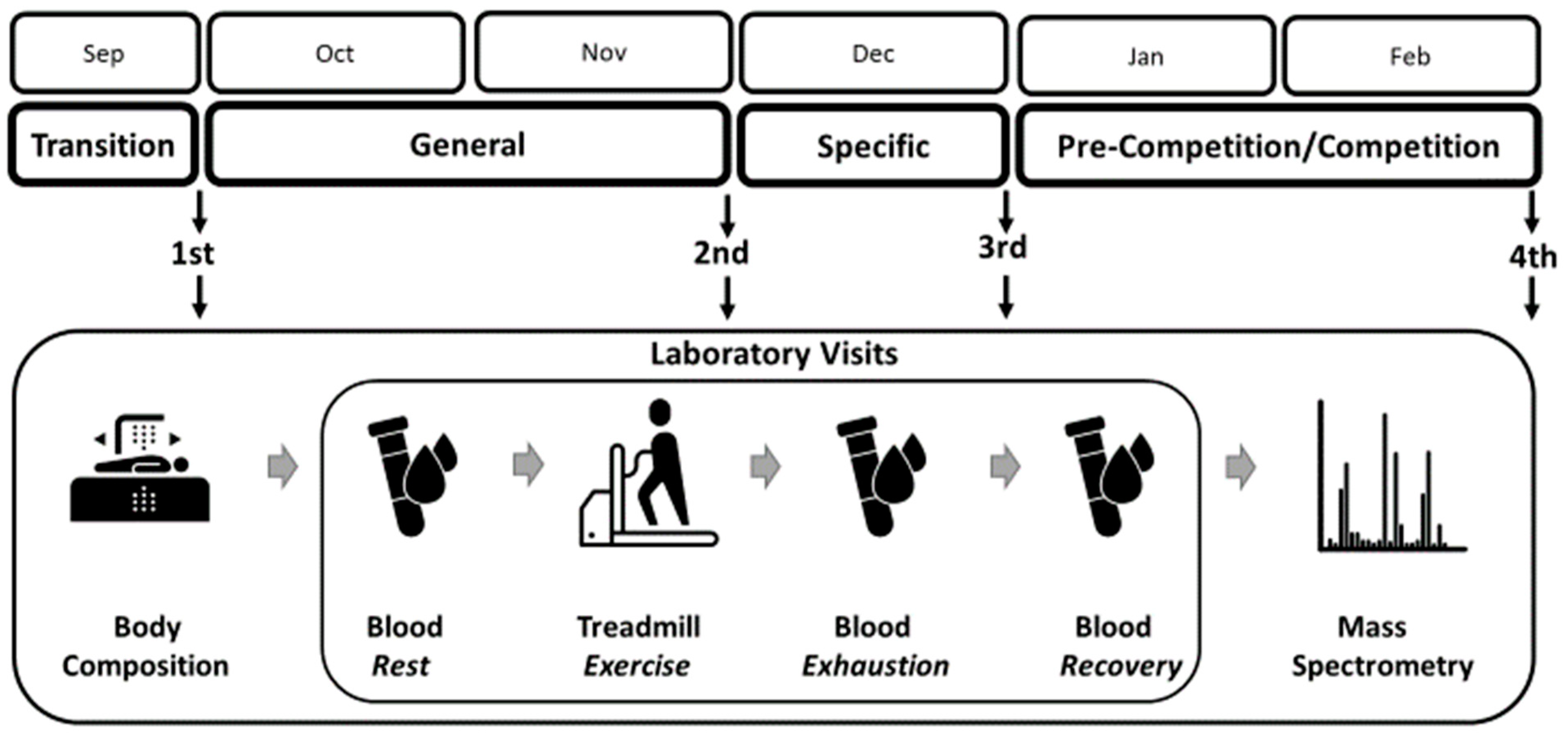

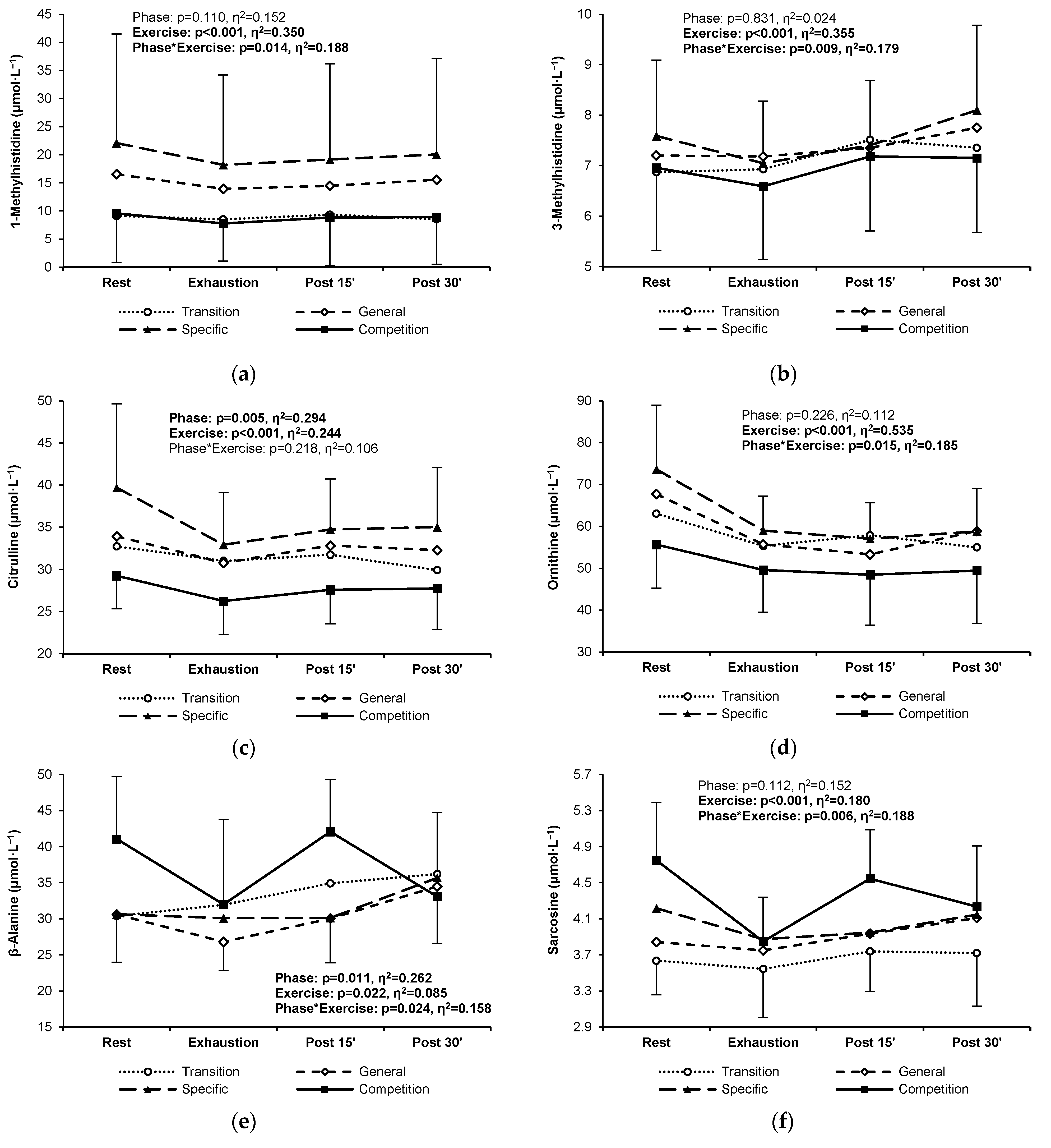
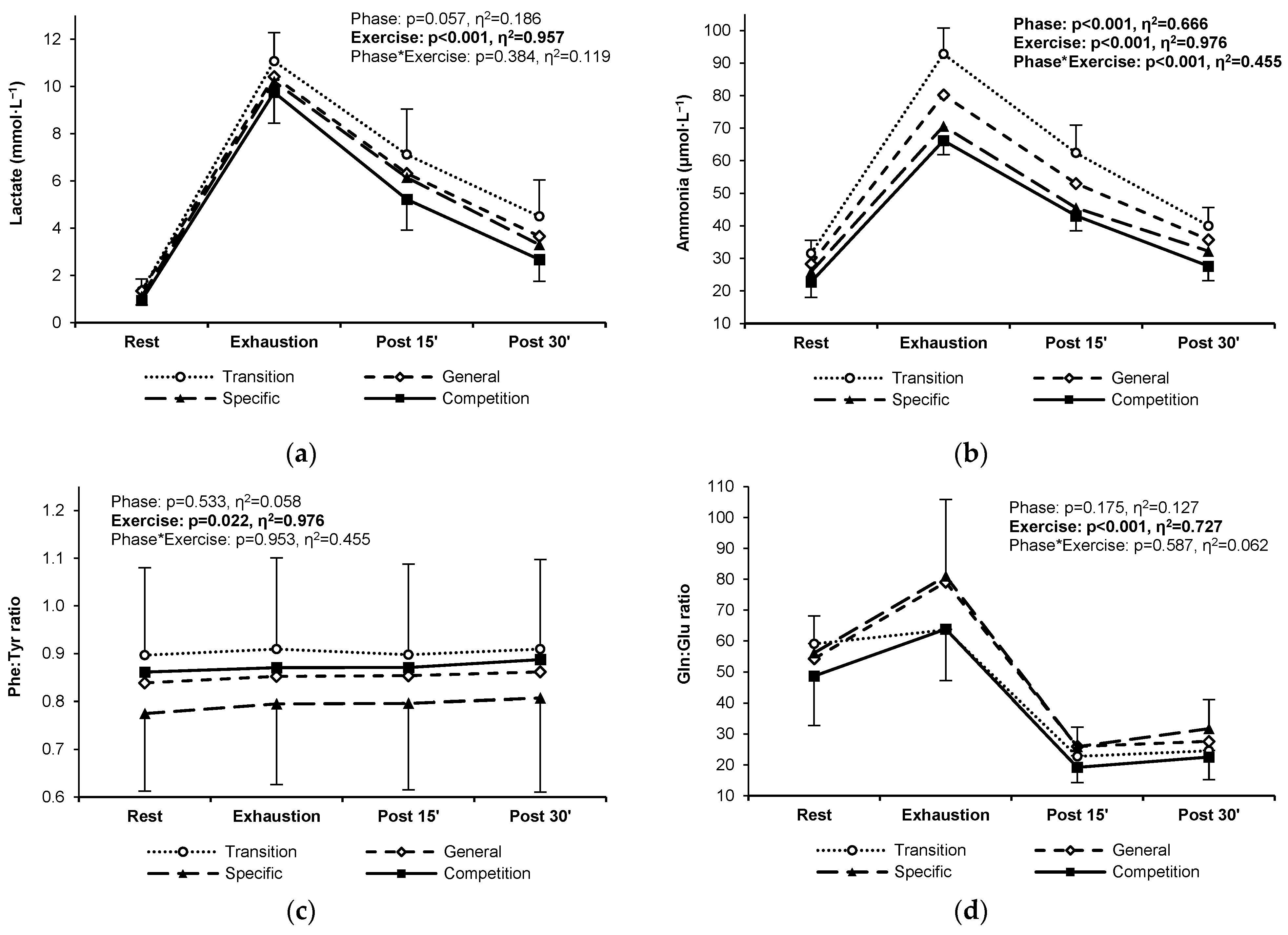
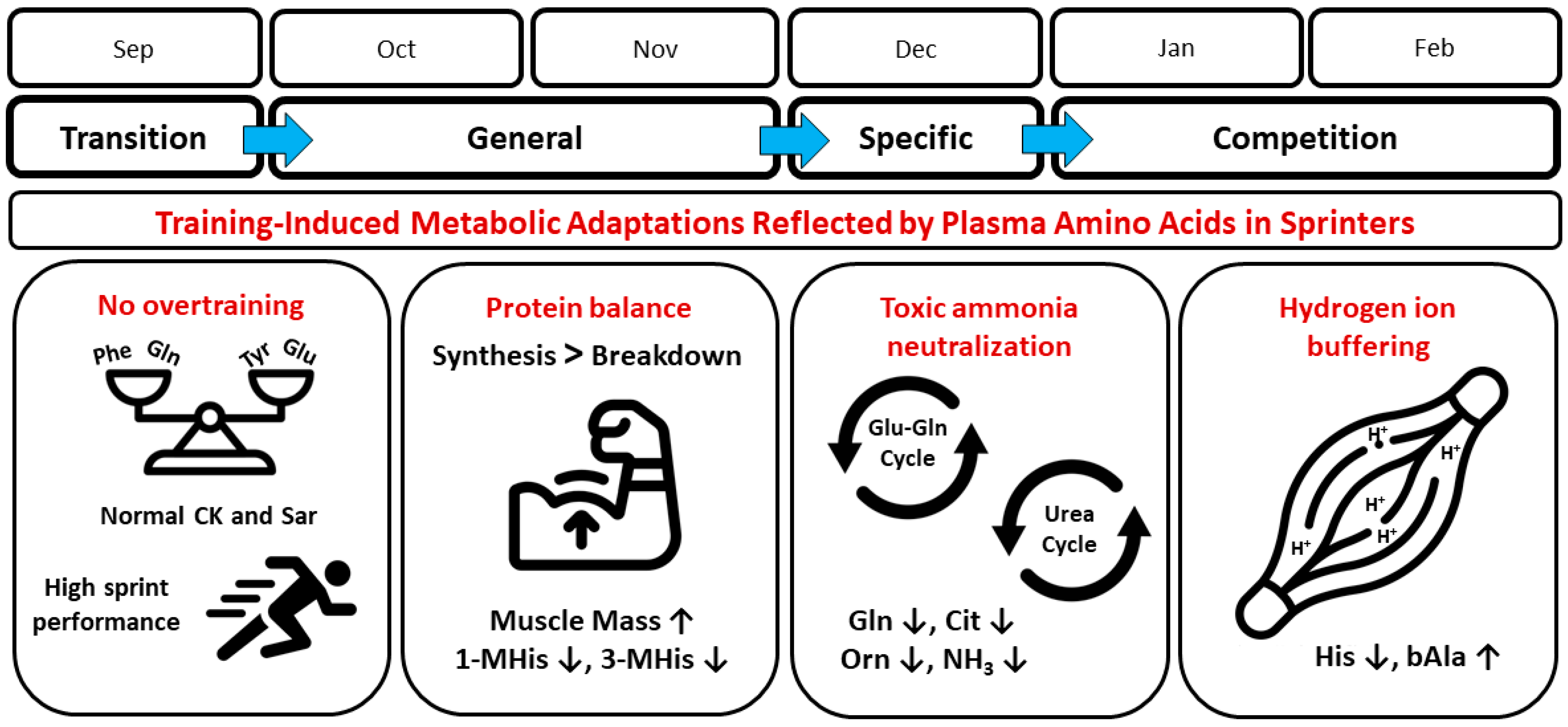
| Transition | General | Specific | Competition | ANOVA p-Value | η2 | |
|---|---|---|---|---|---|---|
| Weight (kg) | 82.0 ± 5.8 | 82.3 ± 6.5 | 82.9 ± 6.1 | 83.4 ± 7.1 | 0.055 | 0.24 |
| BMI (kg·m−2) | 23.9 ± 1.0 | 23.9 ± 1.3 | 24.1 ± 1.2 | 24.3 ± 1.2 | 0.061 | 0.23 |
| FM (kg) | 10.3 ± 2.2 | 9.0 ± 1.7 # | 8.9 ± 1.8 # | 8.8 ± 1.5 # | 0.002 * | 0.43 |
| FM (%) | 12.6 ± 3.1 | 11.0 ± 2.5 # | 10.8 ± 2.5 # | 10.7 ± 2.3 # | 0.001 * | 0.45 |
| LBM (kg) | 68.1 ± 6.4 | 69.7 ± 6.9 | 70.3 ± 6.5 # | 70.9 ± 7.5 # | <0.001 * | 0.48 |
| LBM (%) | 82.9 ± 3.1 | 84.6 ± 2.6 # | 84.7 ± 2.6 # | 84.8 ± 2.3 # | 0.001 * | 0.46 |
| ALST (kg) | 33.0 ± 3.7 | 34.0 ± 3.9 | 34.2 ± 3.7 | 35.0 ± 4.6 # | 0.009 * | 0.35 |
| RSMI (kg·m−2) | 9.6 ± 0.8 | 9.9 ± 0.8 | 9.9 ± 0.9 | 10.2 ± 0.9 # | 0.006 * | 0.37 |
| SMM (kg) | 38.4 ± 4.1 | 39.5 ± 4.5 | 39.7 ± 4.2 | 40.7 ± 5.2 # | 0.009 * | 0.34 |
| SMM (%) | 46.7 ± 2.3 | 47.9 ± 1.9 | 47.9 ± 2.0 | 48.6 ± 2.4 # | 0.015 * | 0.32 |
| WBC (109·L−1) | 5.31 ± 1.18 | 4.67 ± 0.79 | 5.03 ± 1.15 | 5.33 ± 1.40 | 0.187 | 0.16 |
| RBC (1012·L−1) | 4.98 ± 0.43 | 4.81 ± 0.31 | 4.76 ± 0.25 | 4.83 ± 0.36 | 0.067 | 0.23 |
| Hb (g∙dL−1) | 8.84 ± 0.67 | 8.71 ± 0.40 | 8.79 ± 0.35 | 8.91 ± 0.42 | 0.500 | 0.08 |
| HCT (%) | 42.0 ± 3.1 | 42.4 ± 2.1 | 41.5 ± 1.9 | 42.1 ± 2.4 | 0.725 | 0.05 |
| CK (U·L−1) | 370 ± 328 | 499 ± 307 | 401 ± 224 | 319 ± 122 | 0.207 | 0.15 |
| VO2max (L·min−1) | 4.24 ± 0.35 | 4.37 ± 0.42 | 4.28 ± 0.43 | 4.29 ± 0.40 | 0.715 | 0.05 |
| VO2max (L·min−1·kg weight −1) | 51.9 ± 4.6 | 53.4 ± 6.9 | 51.7 ± 4.4 | 51.5 ± 3.5 | 0.513 | 0.08 |
| VO2max (L·min−1·kg SMM −1) | 111.2 ± 12.2 | 111.8 ± 18.2 | 108.3 ± 11.6 | 106.2 ± 9.7 | 0.309 | 0.12 |
| HRmax (bpm) | 188 ± 10 | 190 ± 9 | 190 ± 7 | 189 ± 7 | 0.563 | 0.07 |
| Protein | Fat | Carbohydrate | |
|---|---|---|---|
| Intake | |||
| g·day−1 | 187 ± 29 | 161 ± 41 | 564 ± 139 |
| g·day−1·kg−1 | 2.2 ± 0.2 | 1.9 ± 0.5 | 6.7 ± 1.2 |
| Energy | |||
| kcal·day−1 | 750 ± 116 | 1447 ± 366 | 2178 ± 535 |
| kcal·day−1·kg−1 | 8.9 ± 1.0 | 17.3 ± 4.5 | 25.8 ± 4.7 |
| % energy intake | 17.5 ± 3.0 | 32.9 ± 5.5 | 49.6 ± 5.6 |
Disclaimer/Publisher’s Note: The statements, opinions and data contained in all publications are solely those of the individual author(s) and contributor(s) and not of MDPI and/or the editor(s). MDPI and/or the editor(s) disclaim responsibility for any injury to people or property resulting from any ideas, methods, instructions or products referred to in the content. |
© 2024 by the authors. Licensee MDPI, Basel, Switzerland. This article is an open access article distributed under the terms and conditions of the Creative Commons Attribution (CC BY) license (https://creativecommons.org/licenses/by/4.0/).
Share and Cite
Kusy, K.; Matysiak, J.; Zarębska, E.A.; Klupczyńska-Gabryszak, A.; Ciekot-Sołtysiak, M.; Plewa, S.; Kokot, Z.J.; Dereziński, P.; Zieliński, J. Changes in Plasma Concentration of Free Proteinogenic and Non-Proteinogenic Amino Acids in High-Performance Sprinters over a 6-Month Training Cycle. J. Clin. Med. 2024, 13, 5300. https://doi.org/10.3390/jcm13175300
Kusy K, Matysiak J, Zarębska EA, Klupczyńska-Gabryszak A, Ciekot-Sołtysiak M, Plewa S, Kokot ZJ, Dereziński P, Zieliński J. Changes in Plasma Concentration of Free Proteinogenic and Non-Proteinogenic Amino Acids in High-Performance Sprinters over a 6-Month Training Cycle. Journal of Clinical Medicine. 2024; 13(17):5300. https://doi.org/10.3390/jcm13175300
Chicago/Turabian StyleKusy, Krzysztof, Jan Matysiak, Ewa Anna Zarębska, Agnieszka Klupczyńska-Gabryszak, Monika Ciekot-Sołtysiak, Szymon Plewa, Zenon J. Kokot, Paweł Dereziński, and Jacek Zieliński. 2024. "Changes in Plasma Concentration of Free Proteinogenic and Non-Proteinogenic Amino Acids in High-Performance Sprinters over a 6-Month Training Cycle" Journal of Clinical Medicine 13, no. 17: 5300. https://doi.org/10.3390/jcm13175300
APA StyleKusy, K., Matysiak, J., Zarębska, E. A., Klupczyńska-Gabryszak, A., Ciekot-Sołtysiak, M., Plewa, S., Kokot, Z. J., Dereziński, P., & Zieliński, J. (2024). Changes in Plasma Concentration of Free Proteinogenic and Non-Proteinogenic Amino Acids in High-Performance Sprinters over a 6-Month Training Cycle. Journal of Clinical Medicine, 13(17), 5300. https://doi.org/10.3390/jcm13175300









